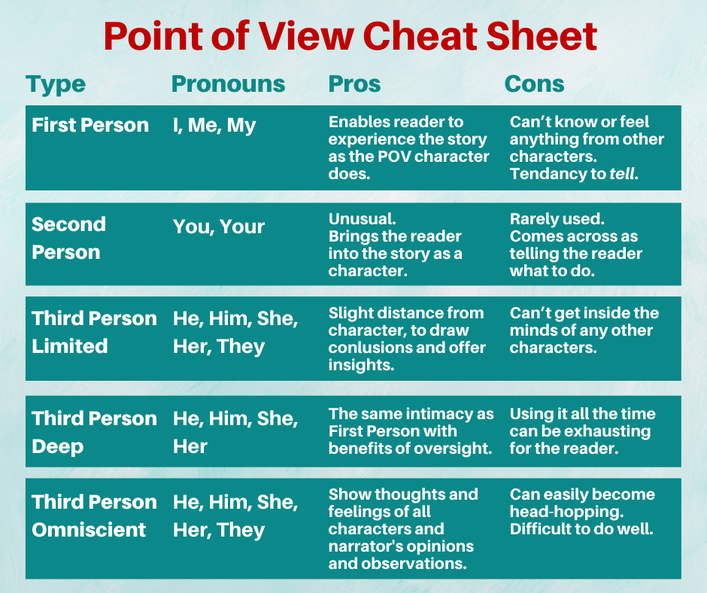|
Author: Sandy Vaile Originally published by Romance Writers Australia Hearts Talk ezine May 2022 . Why POV is important to your novelPoint of View (POV) characters determine the focus of a story, which is why the decision shouldn’t be taken lightly. It’s not just about who is telling the story but how they are the best character to convey information in an interesting and believable way. Whether you decide to use first-person, third-person limited or omniscient POV, you will still have to decide which character is going to communicate the story to readers. But how? Any character who is given the privilege of narrating part (or all) of a story, should:
Who can narrate a story?The decision of who narrates a story is often dictated by genre, but don’t discount the interesting effects achieved by altering the narrator. In romance, it is common to give the hero and heroine a POV, so each of their emotional motivations and insecurities can be explored thoroughly. Whereas, in crime novels there are often many POV characters or an omniscient narrator who sees and knows all. But that doesn’t mean you should limit yourself to the norm. Throughout history there have been more unusual POV characters, like inanimate objects, animals, otherworldly beings and even voyeuristic characters. Here are some examples of unusual POV characters:
Whose story are you telling?Too often authors focus on the subject matter they are writing about and neglect to nail down whose story they are telling. When it is actually the narrator’s view of the world is the compass that will guide story direction and influence structural decisions. Imagine attending a funeral as each of these characters and how it would change the story that would be told of the event.
Each of these characters would not only witness different parts of the event, but would have different perspectives, based on their degree of emotional attachment and history with the deceased. If the estranged brother told the story, it might look like this: Harold returned to England after a decade in exile, to finally get what he was owed from his estranged brother’s estate. Whereas, the herse driver’s story might look like this: Bob kept several magnetic car signs on the back seat because he needed to pay off the car loan; herse driver by day and chauffer by night. Each character in your book has the power to change the way readers view and experience the story. So, think about whose story you want to tell, why you want to tell it and the best character to do it in an interesting and engaging way. Who deserves their own POV scenes?POV characters are the lens through which readers see and experience events in the story. When you give a character their own voice through POV, it provides certain freedoms to explore their thoughts and feelings, as well as limiting what they can see and know about other events and characters. Knowing your audience for the book, will enable you to understand which character(s) they are most likely to sympathise with and want to spend time with. For example, in a Young Adult story readers will want to spend time with the young adults, not their parents or teachers. Therefore, when deciding who you want to narrate your story, consider:
While you have plenty of artistic options when choosing POV characters, it makes sense to let readers experience the story through characters whose desires, motivations and actions align to the main plot thread. One of the biggest mistakes in choosing POV charactersThinking that giving all, or many, characters a voice enables the author to more adequately show what is happening and why, is one of the biggest mistakes when choosing POV characters. The more POV characters you have, the less likely it is readers will connect intimately with them. Think of it as how thinly you spread your resources. You have a limited wordcount within which to tell a story, let’s say 80,000 words for example, and if you have eight POV characters, they each only get 10,000 words to reveal who they are, what they want and what drives them to get it. This might not be an issue if the point of telling the story is to solve a crime and delve into each facet of the enigma, rather than the past and future lives of the characters. If the same story had four POV characters, they would each get 20,000 words to reveal who they are, and if there were two POV characters, they would each get 40,000 words. Imagine how much more deeply you could explore their psyches, desires and emotions if they had more of a voice. This is precisely why romance stories tend to stick to one or two POV characters. That way the author has plenty of time to connect readers to those characters and enable them to experience events with the characters and feel emotions on their behalf. What to do once you've chosen the POV character(s)Once you have decided whose story you are telling and the best character(s) to reveal the information to readers in an interesting and believable way, all that’s left to do is make them human (even if they’re not), by ensuring they are multi-faceted and interesting narrators who drive the story to its conclusion and to remain consistently within the confines of your chosen POV narrators.
That’s where Sandy Vaile can help.
0 Comments
Your comment will be posted after it is approved.
Leave a Reply. |
Fearless ProseEmpowering aspiring authors to confidently write novels they're proud to publish Categories
All
Archives
May 2024
|
© Sandy Vaile 2012-2024 |
Contact and Privacy Policy - About Sandy |




 RSS Feed
RSS Feed